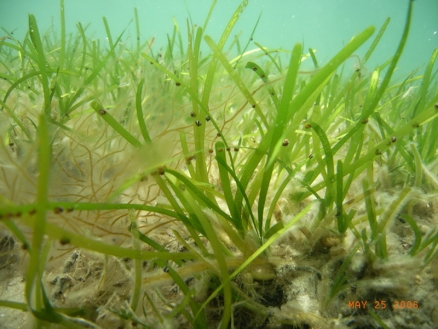Eelgrass: Protection from physical impacts
Contents
Protecting Eelgrass from Physical Impacts
Eelgrass (Zostera marina) provides a variety of essential ecosystem services, including habitat for shellfish and finfish, food chain production, and sediment stabilization. However there are currently a number of physical threats to eelgrass beds in coastal waters. These include dredging, trawling, mooring lines, coastal development and modification, and sediment re-suspension by commercial and personal vessels. Maintaining healthy eelgrass beds will require monitoring and reducing the effects of these anthropogenic physical impacts.
In addition to reducing the physical impacts described in this article, sustaining the health of eelgrasses requires a holistic approach that includesrestoring lost eelgrass bedsas well as related coastal habitats such as salt marshes and shellfish beds,, improving water quality, implementing appropriate legal protections, and developing community ties to eelgrasses and other coastal ecological communities.
Dredging
Dredging poses one of the most obvious threats to eelgrass. When dredging and deepening channels, eelgrass is destroyed in the dredging machine’s sediment intake. Additionally, increased channel depth can render the bottom below the depth of adequate light penetration necessary for eelgrass survival. Also, dredged sediment for many projects is often disposed of in shallow marine areas, as seen in the Cleveland Ledge sediment disposal site in Buzzards Bay, Massachusetts. In addition to covering and killing existing eelgrass beds, the dredged sediment may not be suitable for future eelgrass sites, depleting future potential eelgrass habitats.
Trawling
Trawling also poses a great threat to eelgrass survival. Trawl nets that are dragged along the ocean (Seas of the world) bottom rip eelgrass from the sediment, suspending the organism in the water column. This, in turn, kills the organism as suspended eelgrass cannot resettle and replant itself on the ocean floor.
Coastal Development
Coastal development and coastline modification also poses a threat to eelgrass. Just as coastlines experience natural migrations through constant erosion and deposition, eelgrass will naturally migrate with the coastline. As the Intergovernmental Panel on Climate Change (IPCC) estimates that the global average sea level will rise between 0.6 and 2.0 feet over the next century (IPCC, 2007), the impacts of sea level rise on eelgrass habitats is of particular interest.
As with barrier islands and beaches, eelgrass beds can migrate in response to changes in sea level or coastline shape. Unfortunately, many man-made structures prevent the eelgrass from its natural migration. Shore-perpendicular structures such as docks and jetties prevent the natural lateral migration of eelgrass up and down the coastline in response to shoreline changes. Also, as sea level rises and shallow marine areas migrate landward, eelgrass movement will be inhibited by shore-parallel features such as seawalls.
Sediment Resuspension
Finally, sediment resuspension from vessels and shellfishing reduces water clarity and, thus, diminishes light penetration, which can be lethal for eelgrass while in the water column. Furthermore, this resuspended sediment will often settle directly onto eelgrass leaves, effectively preventing necessary light penetration and effectively killing the eelgrass.
Spotlight: Monitoring eelgrass extent in Massachusetts
Important steps that must be taken to fully understand the value of our current resource is the comprehensive mapping and assessment of existing eelgrass beds in Massachusetts waters, along with a better knowledge of the historic distribution of eelgrass beds and their relationships to other coastal ecosystems such as shellfish beds and salt marshes. Currently, MassGIS provides information on eelgrass coverage from studies conducted by DEP in 1995 and 2001, with limited additional studies conducted in 2006 and 2007. However, these studies only examine the physical area covered by eelgrass. In order to truly understand the value of our eelgrass resources, additional information must be gathered.
In addition to general area coverage, eelgrass beds must be monitored for their overall health. Studies to examine water quality, clarity, and chemistry are necessary to monitor the health of the eelgrass. Additionally, a full assessment of the ecosystems service value of eelgrass must include an evaluation of eelgrass bed’s biomass. Such assessment will help us better understand the productivity and capacity of the eelgrass.
Such studies are currently in progress, though only on a small scale. Through the Cape Cod Bay Nearshore Mapping Project, funded by CZM and conducted by the Provincetown Center for Coastal studies, such assessment is finally getting underway. This study uses state of the art inferometric sidescan sonar to map bedforms and objects on the seafloor. In addition to preliminary mapping, which provides a visual representation of eelgrass coverage, further groundtruthing and sampling provide a more accurate picture. Information on eelgrass density and maturity is measured and then used to infer the total biomass of the eelgrass beds. Using this monitoring method, a much more accurate evaluation of this total is possible.
Further Reading
- Buzzard’s Bay National Estuary Program. Information about eelgrass in Buzzards Bay Massachusetts. Retreived from http://www.buzzardsbay.org/eelgrass.htm.
- Coastal Zone Management Office, Massachusetts Executive Office of Energy and Environmental Affairs (2009). Massachusetts Ocean Management Plan. Boston, MA.
- IPCC, 2007: Climate Change 2007: Impacts, Adaptation and Vulnerability . Contribution of Working Group II to the Fourth Assessment Report of the Intergovernmental Panel on Climate Change Martin L., Canziani, Osvaldo F., Palutikof, Jean P., van der Linden, Paul J., and Hanson, Clair E. eds.. Cambridge University Press, Cambridge, UK, 1000 pages
Note: This article is part of a series of articles by the author known as A Sustaining Eelgrass (Zostera marina) Reader
